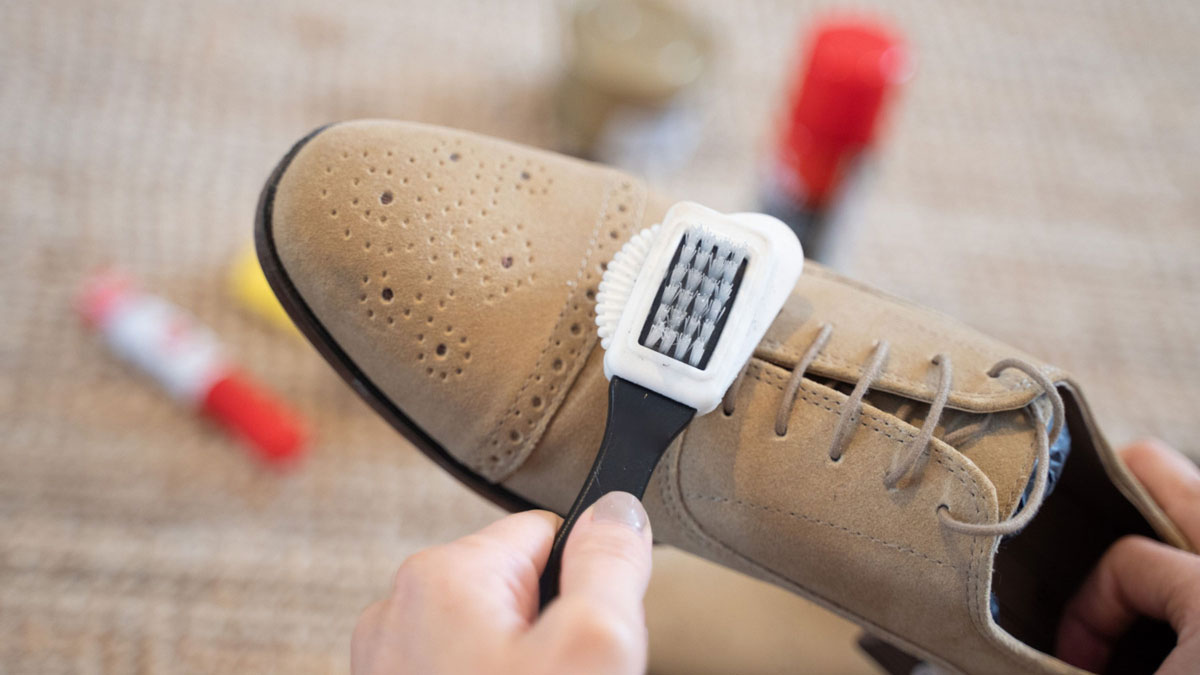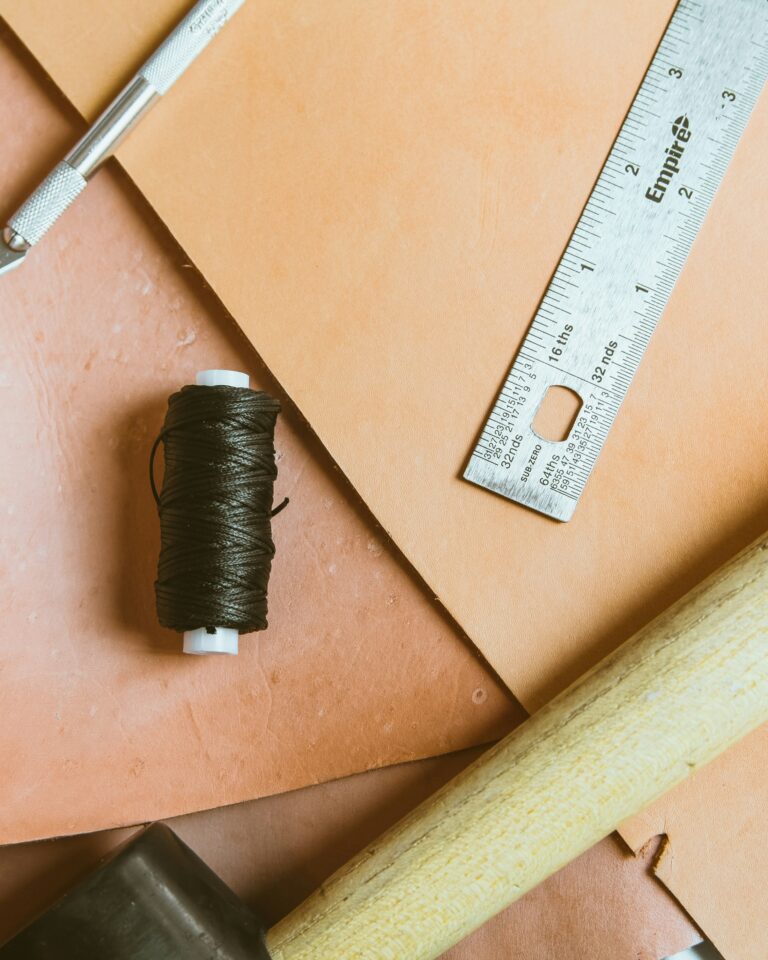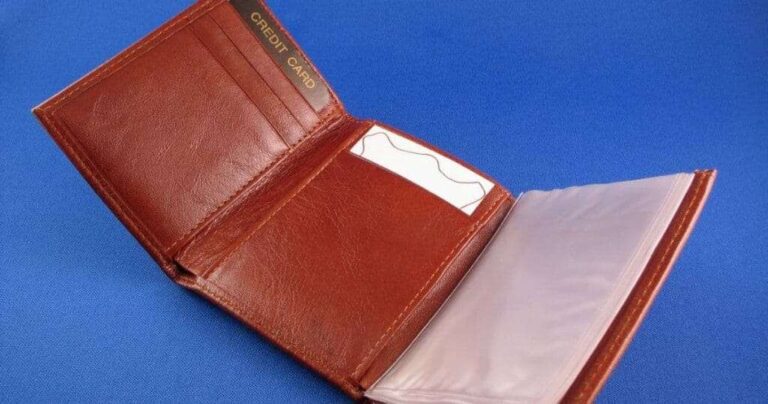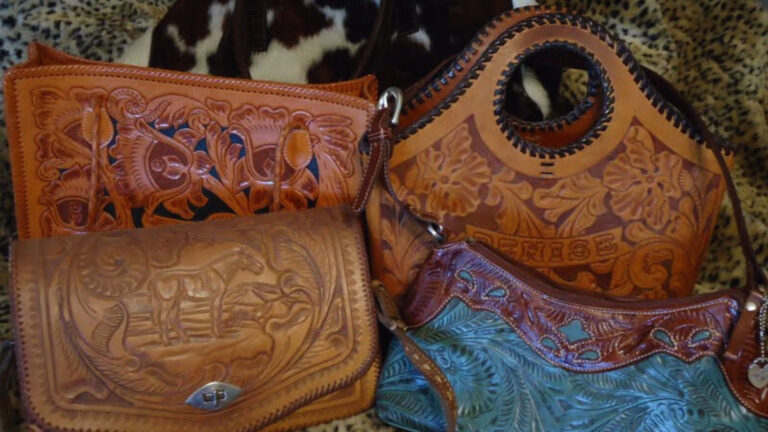How to Clean Nubuck Leather: Expert Cleaning Tips
Nubuck leather, with its luxurious velvet-like texture, is a favorite for its durability and strength. Unlike suede, nubuck is crafted from the outer side of cowhide, making it more robust yet equally prone to soiling and staining. Whether it’s your beloved shoes or a cherished handbag, knowing how to maintain nubuck is essential for keeping it in pristine condition.
Cleaning nubuck leather can seem daunting, but with the right tools and techniques, you’ll have your pieces looking like new. A gentle touch with a nubuck cloth can work wonders for removing surface dirt. For those stubborn stains, a nubuck brush or even a clean toothbrush can help lift away grime without damaging the delicate nap.
When regular cleaning methods fall short, don’t despair. Sanding the surface with a suede block or sandpaper can effectively tackle the toughest stains, restoring your nubuck to its former glory.
Key Takeaways
- Understanding Nubuck Leather: Nubuck leather is made from the outer layer of cowhide, offering durability and a soft, velvet-like texture akin to suede yet more robust and resistant to wear.
- Differences Between Nubuck and Suede: Unlike suede, nubuck is derived from the outer layer of the hide, resulting in a thicker and more durable texture, though both are susceptible to staining.
- Essential Cleaning Materials: Keeping nubuck leather clean requires specific tools such as a nubuck brush, nubuck cleaner, and a nubuck eraser to maintain its texture and remove dirt effectively.
- Effective Cleaning Techniques: Gently brushing with a nubuck brush and using specialized cleaning products are crucial steps in removing dirt and stains without damaging the leather.
- Protection and Maintenance: Regular brushing, using water-repellent sprays, and immediate stain treatment help preserve nubuck’s luxurious appearance while minimizing wear and tear over time.
What Is Nubuck Leather?
Nubuck leather is a high-quality leather known for its soft texture and unique production process. Unlike suede, nubuck is crafted from the outer layer of a hide, usually cowhide, making it tougher and more durable. This outer layer is sanded and buffed, creating a velvety texture from short protein fibers. Even though being thicker and more resilient than suede, nubuck is vulnerable to stains and requires proper maintenance.
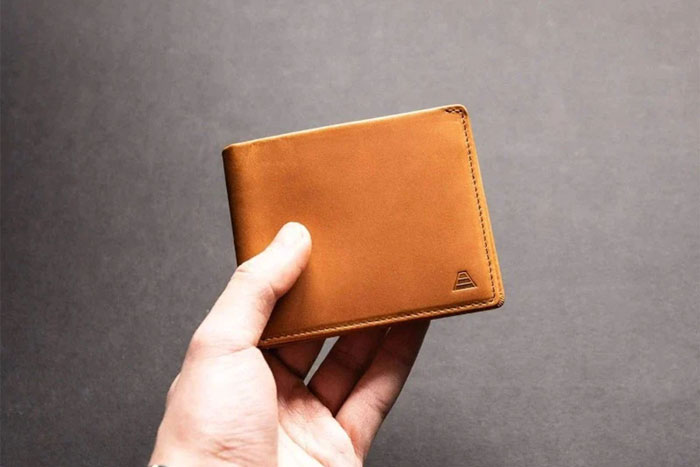
Production Details
- Source: Made from the outer side of the hide.
- Process: Sanded and buffed to achieve a nap.
- Materials: Often from calfskin or older bovine leather.
Key Characteristics
- Texture: Soft and velvety, similar to fine velvet.
- Durability: Thicker and more robust than suede, yet prone to soiling.
- Appearance: Typically dyed to mask imperfections from the sanding process.
| Feature | Nubuck | Suede |
|---|---|---|
| Layer | Outer layer of the hide | Inner layer of the hide |
| Durability | More resilient and tougher | Softer and more delicate |
| Texture | Velvety with a slight nap | Smooth and slightly furry |
Nubuck’s nap contributes to its distinct appearance but also makes it porous and susceptible to stains. To keep nubuck products looking their best, cleaning techniques proven effective for suede, such as brushing and sanding, are also necessary for nubuck.
Differences Between Nubuck and Suede
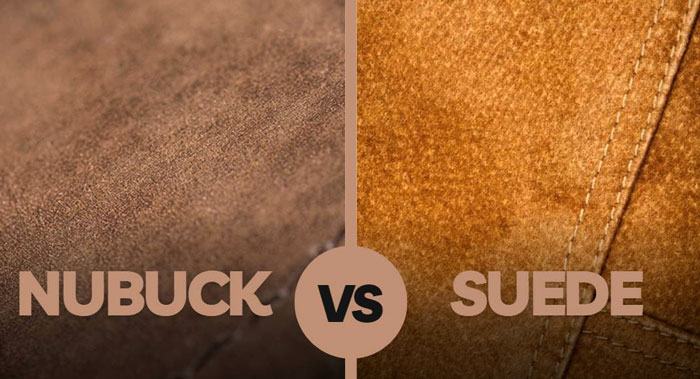
Understanding the differences between nubuck and suede is essential if you’re caring for leather items. Both nubuck and suede are made from cowhide, but they differ in terms of texture, durability, and the processes used to create them.
- Source of Material: Nubuck is made from the outer layer of cowhide, known as full grain, while suede derives from the inner layer. The outer layer is stronger and provides a rougher texture, whereas the inner layer is softer and offers a more delicate feel.
- Texture and Finish: The nubuck’s texture resembles that of velvet due to the sanding and buffing of the outer hide. This process results in a thicker, more durable finish compared to suede, which is thinner and smoother after similar treatment of the inside layer.
- Durability: Nubuck is generally more robust than suede because it retains the outer hide’s integrity. This durability makes nubuck suitable for items requiring more resilience, like footwear, bags, and upholstery.
- Susceptibility to Staining: Both materials are vulnerable to soiling, but nubuck is slightly more resistant due to its denser structure. That said, nubuck often requires protective treatments against moisture and stains.
- Appearance: To hide markings left by the sanding process, nubuck is typically dyed. This staining process results in a more uniform color over time, whereas suede tends to show natural variations and remains less uniformly colored.
- Cost: Because of its durability and the processes involved in its finishing, nubuck is typically more expensive than suede. This cost often reflects in the maintenance and care products offered for nubuck.
By keeping these differences in mind, you can make informed decisions about the care of your nubuck and suede items, selecting the appropriate cleaning methods and protective treatments to maintain their condition.
Materials Needed for Cleaning Nubuck
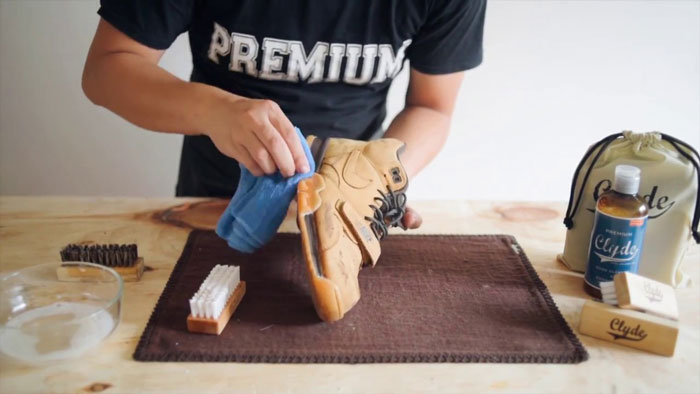
When you’re cleaning nubuck leather, gather the right materials to ensure effective and safe maintenance.
Cleaning Tools
- Lint-free cloth: Essential for gently cleaning and blotting the nubuck surface without leaving any lint or fibers behind.
- Nubuck brush or suede brush: A soft-bristled brush is used to lift dirt from the nap of the nubuck leather. Move it in circular motions to maintain the surface integrity.
Cleaning Products
- Nubuck cleaner: Use a product specifically designed for nubuck leather, like Leather Honey Suede & Nubuck Cleaner. These cleaners clean effectively without harming the leather.
- Nubuck eraser (suede eraser): Perfect for removing stains. Household erasers, such as a white pencil eraser, can serve as substitutes if needed.
- Small, handheld vacuum: Ideal for removing loose dirt and debris from larger nubuck items. Attach a soft-bristle to prevent scuffing the leather surface.
These materials form the foundation for maintaining nubuck leather, offering protection and cleanliness while preserving its luxurious texture and durability.
Steps to Clean Nubuck Leather
Cleaning nubuck leather requires specific techniques to preserve its luxurious texture and durability. Follow structured methods to ensure effective maintenance.
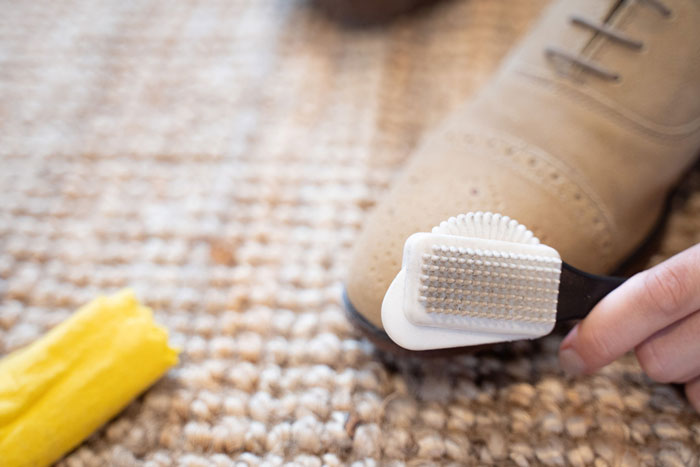
Brushing Away Dirt
- Vacuum to remove loose dirt. Use a small handheld vacuum with a soft-bristle attachment for larger items.
- For smaller items, brush the surface gently. Choose a lint-free cloth or nubuck/suede sponge, used dry, to avoid leather damage.
- Use a suede brush or soft-bristled nubuck brush for deep cleaning. Move in circular motions to lift dirt without causing wear.
Handling Light Stains
- Erase minor marks with a nubuck eraser or suede eraser. Apply it in gentle circular motions using minimal pressure.
- Use a foaming cleaner for tougher stains. Select one designed specifically for nubuck and suede to ensure it effectively removes stains without degrading the leather.
- Remove loose salt deposits using a clean toothbrush or nubuck brush. This prevents embedding of saline particles into the leather.
- Vinegar solution dissolves salt. Dampen a clean cloth with distilled white vinegar and gently rub in circular motions over stains.
- Manage heavy salt staining by using diluted detergent. Combine a few drops of laundry detergent or dishwashing liquid with warm water. Dab a slightly damp cloth onto the stain until it’s gone.
- Ensure proper drying using newspapers. Stuff shoes or surfaces with crumpled newspaper and allow them to dry naturally, avoiding artificial heat.
Tackling Tough Stains on Nubuck
Dealing with tough stains on nubuck leather, like oil, grease, and other persistent marks, requires specific techniques to maintain the material’s luxurious finish. This section provides detailed guidance on removing these challenging stains.
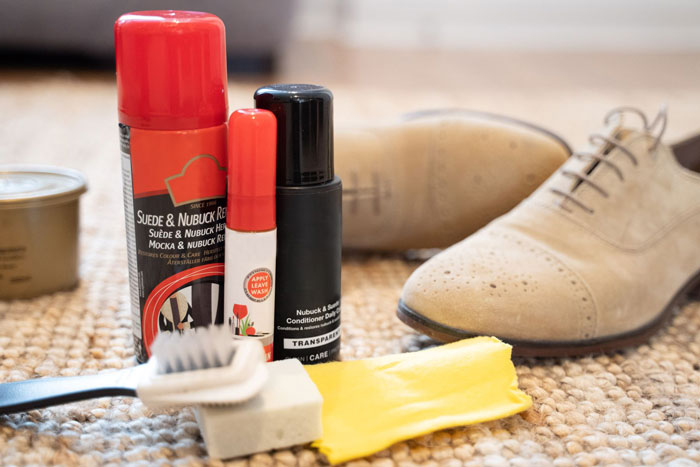
Oil and Grease Stains
Oil and grease stains need careful cleaning to protect the delicate nubuck surface. First, sprinkle cornflour or baking powder over the stain and leave it for at least an hour to absorb excess oil. Use a handheld vacuum or a soft-bristle brush to remove the powder. Next, apply a leather degreaser formulated for nubuck, which turns to powder on contact, soaking up remaining oils. Once the degreaser has absorbed the oil, wipe it away with a cloth. Finish with a regular leather cleaning solution to remove any residue.
Other Persistent Stains
For other persistent stains, you may need to employ different strategies. Ink stains require prompt action; apply a specialized ink lifter before the ink sets, roughly within six hours. For tougher stains, lightly sand the affected area using a suede block or gentle sandpaper, then brush with a nubuck brush to remove dust. Always follow up by raising the nap with a soft brush to restore the leather’s texture.
Tips for Maintaining Nubuck Leather
Protecting and caring for nubuck leather are essential for preserving its luxurious texture and appearance. Proper maintenance minimizes wear and tear, ensuring your nubuck items remain a long-lasting part of your collection.
Protection and Care Strategies
- Regular Brushing: Use a nubuck brush to restore the nap and remove dirt. Brush gently in circular motions to maintain the suede-like texture.
- Avoid Water Exposure: Since nubuck is highly absorbent, keep it away from water and moisture. Use water-repellent sprays specifically designed for nubuck to add a protective layer.
- Prompt Stain Treatment: Address stains immediately. For oily stains, sprinkle cornflour or baking powder and let it absorb the oil before vacuuming or brushing.
- Use Protective Products: Apply conditioners designed for nubuck to maintain softness and prevent cracking.
- Storage: Store nubuck items in a cool, dry place away from sunlight. Use dust bags or cover shoes with shoe trees to maintain their shape.
- Regular Inspections: Regularly check for damage or stains. Early detection allows for timely cleaning and care, preventing permanent damage.
- Professional Cleaning: If severe stains or wear occur, consider professional cleaning services that specialize in nubuck to ensure its texture is preserved.
- Rotate Use: Rotate your nubuck items to prevent overuse and uneven wear, preserving their appearance and integrity over time.
Incorporating these strategies helps extend the life and beauty of your nubuck leather, making it a lasting investment in your wardrobe.
Conclusion
By mastering the art of cleaning and maintaining nubuck leather, you can preserve its luxurious texture and durability for years. With the right tools and techniques, including regular brushing and prompt stain treatment, your nubuck items will remain a timeless addition to your wardrobe. Remember to protect them from moisture and store them properly to ensure they continue to look their best. Investing in the care of your nubuck leather not only enhances its longevity but also keeps it looking as exquisite as the day you first acquired it.
Frequently Asked Questions
What is nubuck leather?
Nubuck leather is a high-quality leather made from the outer side of cowhide. It undergoes sanding and buffing to create a soft, velvety texture and is known for its durability and luxurious feel.
How does nubuck compare to suede?
Nubuck is tougher and more resilient than suede. While nubuck is made from the outer layer of cowhide, suede comes from the inner layer. This makes nubuck thicker and more durable, though both types are vulnerable to staining.
How do I clean nubuck leather?
For regular cleaning, use a lint-free cloth to wipe off surface dirt and a nubuck brush for stubborn stains. A nubuck eraser or cleaner can help with light stains. Vacuum to remove loose dirt, and for deeper cleaning, circular motions with a suede brush are recommended.
Can you get nubuck wet?
Nubuck should be protected from water. Exposure to moisture can cause stains and alter its texture. Using a waterproof spray specifically designed for nubuck is recommended to repel moisture.
How do I remove oil stains from nubuck?
Sprinkle cornflour or baking powder over the oil stain and let it sit to absorb the oil. Afterward, brush off the powder, and use a leather degreaser for nubuck if needed to completely remove the stain.
What’s the best way to maintain nubuck leather?
Regular brushing to restore the nap, using conditioners, and avoiding water exposure are vital. Prompt stain treatment and protective products help preserve its luxurious appearance. Proper storage in a cool, dry place is also essential.
Can nubuck be restored after damage?
Yes, nubuck can often be restored by cleaning and using products like nubuck conditioners that help rejuvenate its texture. Sanding with a suede block may also aid in improving the texture after cleaning.
How often should I clean nubuck leather?
It’s advisable to clean nubuck leather as needed based on usage, with light cleaning after each use if exposed to dirt. A more thorough cleaning can be scheduled every few months or when visible stains appear.

